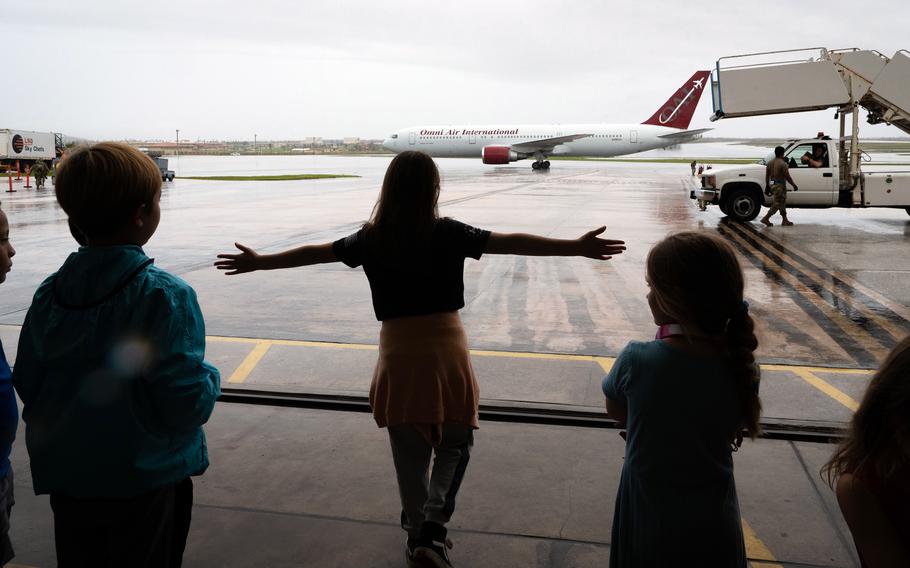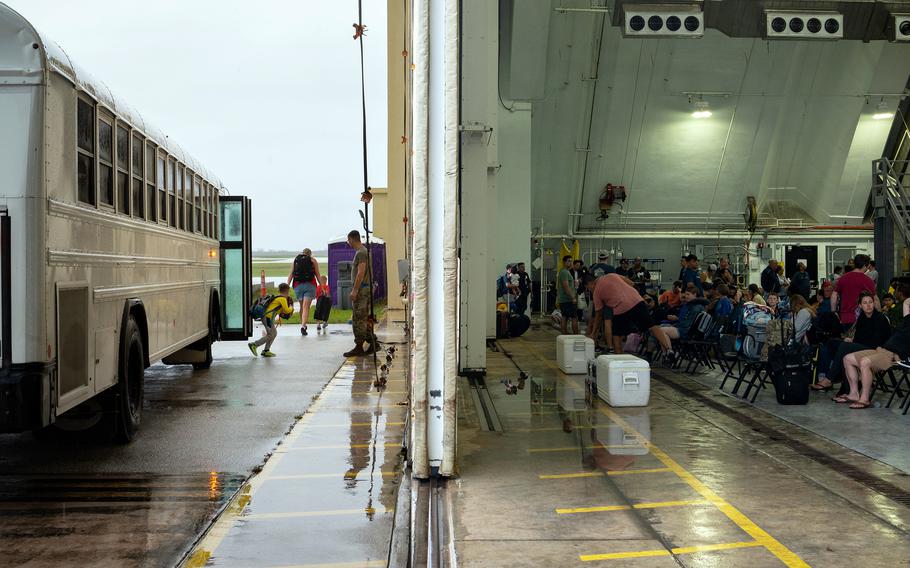
Children watch as the Patriot Express touches down in front of a temporary passenger terminal at Andersen Air Force Base, Guam, May 30, 2023. (Pedro Tenorio/U.S. Air Force)
Hundreds of people waited for passenger flights Wednesday in an Andersen Air Force Base hangar normally reserved for military operations, one of the many consequences of Typhoon Mawar’s passing last week.
The storm caused “significant damage” to Andersen’s passenger terminal, where travelers arrive and depart aboard the Patriot Express, a government-contracted air service. To remedy the situation, the 734th Air Mobility Squadron turned the 4th Reconnaissance Squadron hangar into a temporary terminal, according to the Defense Visual Information Distribution Service.
Video footage posted on DVIDS by the 36th Wing showed passengers waiting on folding chairs or going through temporary security stations ahead of their flights.
All over Guam, people are making do as they find their way back to normal in Mawar’s wake. More than half the island’s 170,000 people were still without power Thursday afternoon, according to the government’s Joint Information Center. And just 53% of the island’s water system was in working order.

Outbound airmen and their families are dropped off at a temporary passenger termainal on Andersen Air Force Base, Guam, May 30, 2023l. (Pedro Tenorio/U.S. Air Force)
Spokespeople for FEMA and Joint Region Marianas did not immediately respond to requests for comment Thursday.
Mawar tore into Guam on May 24 with 150 mph winds and inundated the island with more than 2 feet of rain in some areas. No deaths were reported, although the typhoon was the strongest to hit the U.S. island territory in decades.
“Recovery from Typhoon Mawar is no quick feat,” Gov. Lou Leon Guerrero wrote in a Facebook post Thursday. “It will take time and collaborative efforts from everyone in this community.”
Thousands are left without basic needs, but the island was spared worse consequences by the rapid response that followed the storm, Leon Guerrero said.
“Within days, not weeks, power and water were restored to critical infrastructure. Our hospital was powered immediately after the typhoon to continue treating our sick,” she said. “Once the typhoon passed, essential commodities and fuel continued to come through our port.”
Parts of Naval Base Guam were still without power Tuesday, base commander Capt. Michael Luckett said at a town hall meeting.
“Power restoration onboard [Naval Base Guam] will take several weeks,” he said. “It’s going to be a phased approach as we start to restore systems here, probably over the next couple of weeks. This is unfortunate, but it is our reality.”
At Andersen, only common access card holders, dependents and some contractors were permitted unlimited base access, according to a post on the installation’s Facebook page. Other ID card holders, including retirees and veterans, among others, were permitted access after noon.
Ahead of the storm, residents stockpiled necessities and reinforced their homes, while U.S. bases sent ships to sea and aircraft to safer locations. The storm flooded streets and buildings, knocked down trees and damaged vehicles, sparing little.
Recovery efforts began the day after Mawar’s eye brushed Guam’s northern edge. Ships and aircraft made their way back to the island, many carrying relief supplies; the island’s Apra harbor port, which serves the naval base and the Port of Guam, reopened alongside the A. B. Won Pat International Airport.
“Each natural disaster presents unique sets of challenges that must be overcome,” the governor wrote on Facebook. “Our island is making record progress in a matter of days compared to the months of recovery it took following Typhoon Pongsona over two decades ago.”